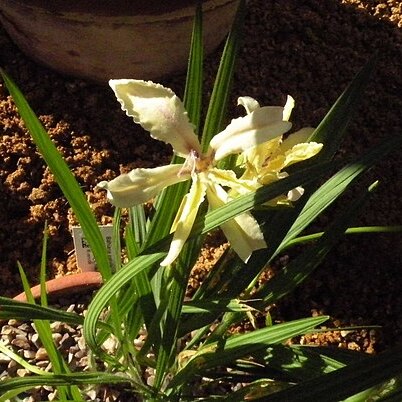Plants mostly 60-100 mm high. Stem usually reaching shortly above ground level, sometimes up to 150 mm high, flexed outward above, velvety-hairy, simple with up to 4 short, ascending branches. Leaves lanceolate, pleated, usually widely divergent, velvety to pilose. Spike decumbent, 3-to 9-flowered; bracts green with dry, rust-coloured apices, hairy, 10-15(-20) mm long, outer truncate to trifid, inner slightly shorter than outer, divided to base. Flowers zygomorphic, mauve to blue, occasionally purple, yellow or white, lower laterals and sometimes lower median yellow, tipped with mauve or entirely yellow, intensely fragrant often of rose or violet; perianth tube narrowly funnel-shaped, 10-14 mm long; tepals unequal, dorsal mostly 20-25 mm long, lower tepals joined to upper laterals for ± 2.5 mm and to one another for ± 2 mm, forming a lip, lower tepals 15-25 mm long. Stamens unilateral; filaments arched, 12-14 mm long; anthers ± 6 mm long. Ovary minutely hairy on ribs (or evidently smooth); style dividing between middle and apex of anthers, branches 3-4 mm long.
More
Subcaulescent, cormous geophyte, 2-8 cm. Leaves longer than stem, lanceolate, hairy. Flowers zygomorphic, mauve to blue with yellow markings or entirely dull yellow, fragrant, inner bracts divided to base, ovary smooth.
A small creeping herb. It grows 2-8 cm long. The leaves are sword shaped and hairy. The flowers are blue to purple with yellow lines.

